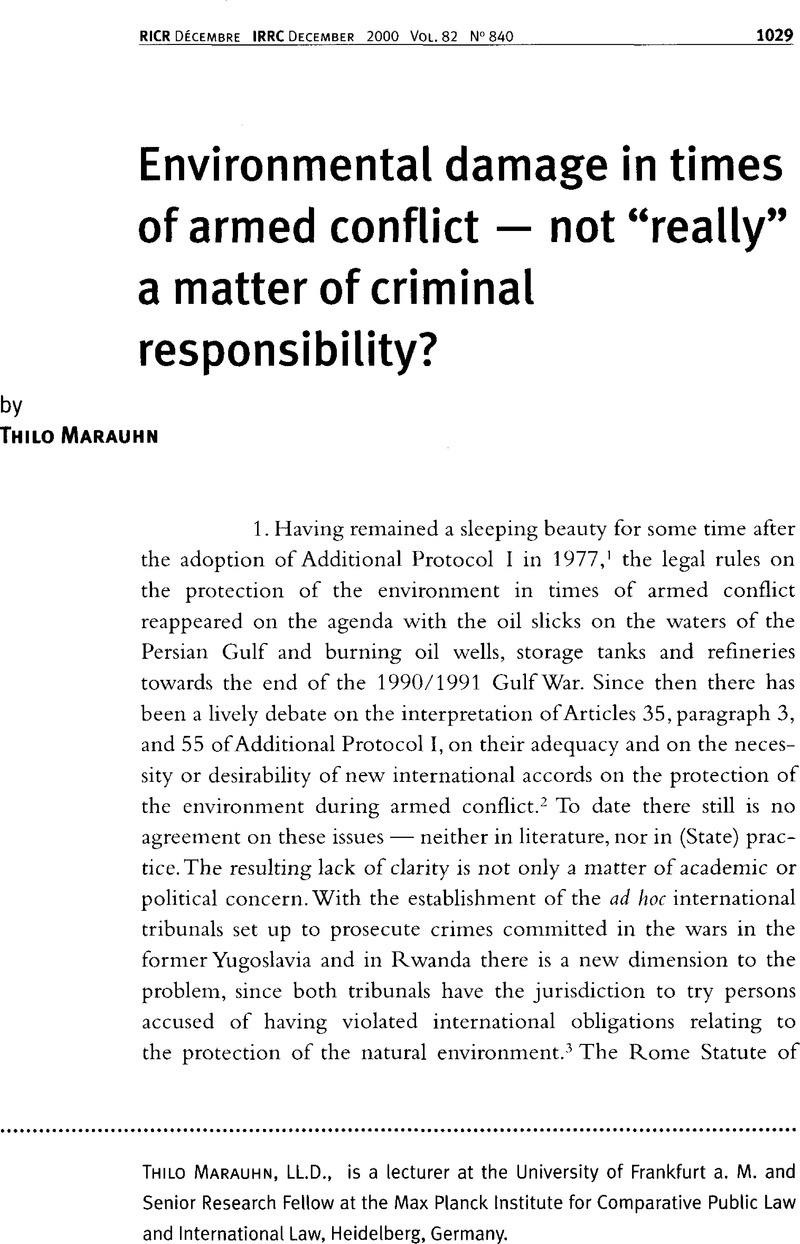Article contents
Environmental damage in times of armed conflict — not “really” a matter of criminal responsibility?
Published online by Cambridge University Press: 27 April 2010
Abstract

- Type
- Research Article
- Information
- Copyright
- Copyright © International Committee of the Red Cross 2000
References
1 Protocol additional to the Geneva Conventions of 12 August 1949, and relating to the Protection of Victims of International Armed Conflicts (Protocol I), 8 June 1977.
2 For an introduction to this subject see Hulme, K., “Armed conflict, wanton ecological devastation and scorched earth policies: How the 1990–91 Gulf conflict revealed the inadequacies of the current laws to ensure effective protection and preservation of the natural environment”, Journal of Armed Conflict Law, 1997, pp. 55–70Google Scholar. More generally on the desirability of new international accords, see Plant, G. (ed.), Environmental Protection and the Law of War: a ‘Fifth Geneva’ Convention on the Protection of the Environment in Time of Armed Conflict, 1992Google Scholar, passim.
3 There are no specific provisions to this end in the respective Statutes. However, Art. 3 of the Statue of the International Criminal Tribunal for the former Yugoslavia (UN Doc. 8/25704, annex (1993)) establishes the power of the Tribunal to prosecute persons violating the laws or customs of war, and Art. 4 of the Statute of the International Criminal Tribunal for Rwanda (UN Doc. S/Res/955 (1994)) refers to violations of Art. 3 common to the 1949 Geneva Conventions and of 1977 Additional Protocol II. See also Gasser, H.-P., “The debate to assess the need for new international accords”, in Grunawalt, R. J. et al. (eds), Protection of the Environment during Armed Conflict, International Law Studies, Naval War College, Newport R.I., 1996, p. 526.Google Scholar
4 Rome Statute of the International Criminal Court, 17 July 1998, Art. 8 (b) (iv).
5 But see Bothe, M., “Criminal responsibility for environmental damage in times of armed conflict”, in op. cit. (note 3), pp. 473–478Google Scholar, and Tanja, G. J., “Individual accountability for environmental damage in times of armed conflict: International and national penal enforcement possibilities”Google Scholar, ibid., pp. 479–490.
6 Final Report to the Prosecutor by the Committee Established to Review the NATO Bombing Campaign Against the Federal Republic of Yugoslavia, paras 14–25. http://www.un.org/icty/pressreal/natoo61300.htm.
7 Ibid., para. 14.
8 Ibid., para. 25.
9 Ibid., para. 15; italics by the author.
10 Legality of the Threat or Use of Nuclear Weapons, Advisory Opinion, I.C.J. Reports 1996, 66.Google Scholar
11 Ibid., p. 242, para. 31.
12 Final Report (note 6), para. 15.
13 Kalshoven, F., “Reaffirmation and development of international humanitarian law applicable in armed conflicts: the Diplomatic Conference, Geneva, 1974–1977”, Part II, Netherland Yearbook of International Law, Vol. IX, 1978, p. 130Google Scholar, referring (note 56) to the Report of Committee III (CCDH/215/Rev. 1, para. 27) and to the Rapporteur's Report to Committee III on the work of the Working Group (CDDH/111/275 and Corr. 1).
14 Report of the CCD, Vol. I GAOR, 31st Session, Suppl. No. 27 (UN Doc. A/31/27), p. 91. Reprinted in A. Roberts/R. Guelff, Documents on the Laws of War, 3rd ed., Oxford University Press, 2000, p. 407.Google Scholar
15 Hulme, , op. cit. (note 1), p. 74Google Scholar. This, however, is in contrast to an explicit clause of the understandings “that the interpretation set forth above is intended exclusively for this Convention and is not intended to prejudice the interpretation of the same or similar terms used in connexion with any other international agreement”.
16 Oeter, S., “Methodsand means of combat”, in Fleck, D. (ed.), The Handbook of Humanitarian Law in Armed Conflicts, Oxford University Press, 1995, p. 117Google Scholar, margin no. 403.
17 Final Report (note 6), para. 15.
18 Roberts, A., “Environmental issues in international armed conflict: The experience of the 1991 Gulf War”, in Grunawalt et al., op. cit. (note 2), p. 228Google Scholar. See also Falk, R., “The environmental law of war: An introduction”, in Plant, op. cit. (note 1), pp. 84–85Google Scholar. Falk adds the principles of neutrality and of intergenerational equity without, however, adding greatly to the existing law.
19 Roberts, ibid., p. 228.
20 Ibid.
21 Bothe, , op. cit., (note 5), p. 474.Google Scholar
22 Final Report (note 6), para. 18.
23 Rogers, A.P.V., “Zero-casualty warfare”, IRRC, No. 837, 03 2000, pp. 177–178.Google Scholar
24 Final Report (note 6), para. 18.
25 Fenrick, W. J., in Triffterer, O. (ed.), Commentary on the Rome Statute, 1999Google Scholar, and Article 8, margin no. 51.
26 Bothe, M., “War and environment”, in Bernhardt, R. (ed.), Encyclopedia of Public International Law, Inst. 4, North Holland, 1982, p. 292.Google Scholar
27 Final Report (note 6), para. 22.
28 UNEP/UNCHS, The Kosovo Conflict: Consequences for the Environment and Human Settlements, 1999Google Scholar; also available via http://www.grida.no/inf/news/news99/finalreport.pdf.
29 Final Report (note 6), para. 17.
30 Ibid.
31 C. Pilloud/J. de Preux, “Article 55”, in Y. Sandoz et al. (eds), Commentary on the Additional Protocols of 8 June 2977 to the Geneva Conventions of 12 August 1949, International Committee of the Red Cross, 1987, p. 663Google Scholar, margin no. 2133.
- 2
- Cited by


